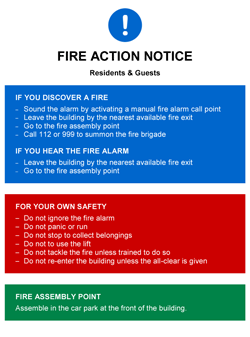The Role of a Fire Action Notice
The occupants of a building should be informed of the actions that they are required to take in the event of a fire emergency. This information should be appropriate to the premises and take the form of a fire instruction notice which should be displayed on the wall over each manual fire alarm call point, adjacent to each storey exit, and at strategic locations throughout the building. Fire action notices should also be provided for disabled persons where applicable.The notice is a printed list of instructions on the actions to be taken by occupants of a building when a fire or other emergency occurs. The notice is divided into two parts depending on whether a person discovers a fire or hears the fire alarm (or other warning of fire).
In buildings where the default fire evacuation strategy is simultaneous evacuation (all occupants exit the building on hearing the fire alarm except staff assigned roles to play in the emergency response such as fire wardens), the first part of the notice will always instruct the person discovering a fire to sound the fire alarm and then to leave by the building by nearest available fire exit.
To enable this action to occur safely, fire alarm call points are positioned along escape routes and adjacent to final fire exits. The first part of the notice may also provide the instruction to tackle the fire with the portable fire extinguishers provided if it is small and it is safe to do so; not to tackle the fire, or to inform a member of staff in workplaces, e.g. security personnel, a fire warden, a manager, etc., without incurring additional personal risk by unduly delaying his/her own exit. The first part of the notice may also include instruction for the person discovering the fire to call the fire brigade and provide the procedure for doing so.
The second part of the notice is addressed to persons hearing the fire alarm (as opposed to the person discovering the fire) and will always instruct the occupants to leave by the building by nearest available fire exit and then proceed to the fire assembly point or to assemble at a safe distance from the building if there isn’t a fire assembly point. It may also include instruction for the occupants to close all fire doors and windows behind them along the escape routes where safe to do so.
The notice may also include a section prohibiting a list of unsafe behaviours, such as:
- Do not ignore the fire alarm
- Do not panic or run
- Do not stop to collect belongings
- Do not to use the lift
- Do not tackle the fire unless trained to do so
- Do not re-enter the building unless the all-clear is given
If the notice is not addressed to all persons on the premises then it should be addressed to the category of occupant for whom it is provided, e.g. visitors, staff, etc. This will prevent confusion occurring where different actions are required from different occupants.
Generic fire action notices may be suitable for premises where the default fire evacuation strategy is simultaneous evacuation but it is important that the instructions provided are appropriate to the premises and do not contradict the actual procedures in operation. These generic notices are not suitable for use in premises where a different evacuation strategy such as progressive horizontal evacuation is applicable, e.g. nursing homes, hospices, and hospitals.
Fire action notices are classified as safety signs under the Safety, Health and Welfare at Work (General Application) Regulations 2007 and should therefore use colour coding as follows:
- White text on a blue background for mandatory actions
- White text on a red background for prohibited actions
- White text on a green background for safe condition/means of escape instructions

Antrim, Armagh, Carlow, Cavan, Clare, Cork, Derry, Donegal, Down, Dublin, Fermanagh, Galway, Kerry, Kildare, Kilkenny, Laois, Leitrim, Limerick, Longford, Louth, Mayo, Meath, Monaghan, Offaly, Roscommon, Sligo, Tipperary, Tyrone, Waterford, Westmeath, Wexford, and Wicklow



